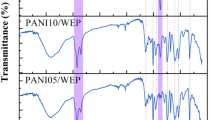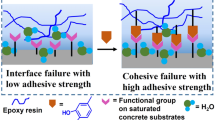Abstract
Epoxy adhesive as an engineering material has more and more applications in industry. But to date, water resistance of the adhesive is still a very difficult problem to be solved. By mimicking mussel adhesive proteins, dopamine (DA) was applied as one of the two curing agents of epoxy adhesive to improve the water resistance of the adhesive, and the other was phenethylamine (PEA). The effects of the contents of DA on both adhesion property and water absorption of epoxy/PEA/DA adhesives were investigated in detail. The results of lap shear test (LST) showed that the adhesion strength of the epoxy adhesives after the introduction of proper amount of DA was still up to 7 MPa even after the sample was immersed in water for over 230 days. And then the effects of metal ions Zn(II) and Fe(III) on the adhesion properties of the epoxy adhesives were also further studied. It was found that the adhesion strength of the adhesives, when the content of DA was no more than 5 wt%, can be further increased through the complexation of a small quantity of ferric ions with DA. The coordination mechanism of catechol with Fe(III) ions in the system has been investigated by both UV/Vis spectra and XRD curves. The results testified that more bis-catecholate complexes form at high DA: Fe ratios and thus the adhesives have higher cohesion strength for having more regular structures after curing. In a word, the introductions of proper amount of DA and metal ion endow the epoxy adhesive better water resistance and excellent adhesion properties.









Similar content being viewed by others
References
Popineau S, Rondeau-Mouro C, Sulpice-Gaillet C et al (2005) Free/bound water absorption in an epoxy adhesive. Polymer 46(24):10733–10740
Oudad W, Madani K, Bouiadjra B et al (2012) Effect of humidity absorption by the adhesive on the performances of bonded composite repairs in aircraft structures. Compos B Eng 43(8):3419–3424
Khashaba UA, Aljinaidi A, Hamed MA (2015) Development of CFRE composite scarf adhesive joints with SiC and Al2O3 nanoparticle. Compos Struct 128:415–427
Ting JAS, Rosario LMD, Lacdan MC et al (2013) Enhanced adhesion of epoxy-bonded steel surfaces using O2/Ar microwave plasma treatment. Int J Adhes Adhes 40:64–69
Gude MR, Prolongo SG, Urena A (2013) Hygrothermal ageing of adhesive joints with nanoreinforced adhesives and different surface treatments of carbon fibre/epoxy substrates. Int J Adhes Adhes 40:179–187
Meis N, van der Ven LGJ, van Benthem R et al (2014) Extreme wet adhesion of a novel epoxy-amine coating on aluminum alloy 2024-T3. Prog Org Coat 77(1):176–183
Liu X, Wang Y, Cao Y et al (2011) Study of dextrin-derived curing agent for waterborne epoxy adhesive. Carbohydr Polym 83(3):1180–1184
Yu J, Wei W, Danner E et al (2011) Effects of interfacial redox in mussel adhesive protein films on mica. Adv Mater 23(20):2362–2366
Lim S, Choi YS, Kang DG et al (2010) The adhesive properties of coacervated recombinant hybrid mussel adhesive proteins. Biomaterials 31(13):3715–3722
Peng Y, Zheng Z, Sun P et al (2013) Synthesis and characterization of polyphenol-based polyurethane. New J Chem 37(3):729–734
Tsai WB, Chen WT, Chien HW et al (2011) Poly(dopamine) coating of scaffolds for articular cartilage tissue engineering. Acta Biomater 7(12):4187–4194
Waite JH, Tanzer ML (1981) Polyphenolic substance of Mytilus edulis: novel adhesive containing l-dopa and hydroxyproline. Science 212(4498):1038–1040
Ye Q, Zhou F, Liu W (2011) Bioinspired catecholic chemistry for surface modification. Chem Soc Rev 40(7):4244–4258
Yu M, Hwang J, Deming TJ (1999) Role of L-3, 4-dihydroxyphenylalanine in mussel adhesive proteins. J Am Chem Soc 121(24):5825–5826
White JD, Wilker J (2011) Underwater bonding with charged polymer mimics of marine mussel adhesive proteins. Macromolecules 44(13):5085–5088
Pan XD, Qin Z, Yan Y et al (2010) Elastomers with chain-end mussel-mimetic modification for nanocomposites: strong modifications to reinforcement and viscoelastic properties. Polymer 51(15):3453–3461
Bernard J, Branger C, Beurroies I et al (2012) Catechol immobilized on crosslinked polystyrene resins by grafting or copolymerization: incidence on metal ions adsorption. React Funct Polym 72(1):98–106
Gao C, Li G, Xue H et al (2010) Functionalizable and ultra-low fouling zwitterionic surfaces via adhesive mussel mimetic linkages. Biomaterials 31(7):1486–1492
Shao H, Stewart RJ (2010) Biomimetic underwater adhesives with environmentally triggered setting mechanisms. Adv Mater 22(6):729–733
Kaur S, Weerasekare GM, Stewart RJ (2011) Multiphase adhesive coacervates inspired by the sandcastle worm. ACS Appl Mater Interfaces 3(4):941–944
Chen S, Cao Y, Feng J (2013) Polydopamine as an efficient and robust platform to functionalize carbon fiber for high-performance polymer composites. ACS Appl Mater Interfaces 6(1):349–356
Lee W, Lee JU, Byun JH (2015) Catecholamine polymers as surface modifiers for enhancing interfacial strength of fiber-reinforced composites. Compos Sci Technol 110:53–61
Deming TJ (1999) Mussel byssus and biomolecular materials. Curr Opin Chem Biol 3(1):100–105
Matos-Pérez CR, White JD, Wilker J (2012) Polymer composition and substrate influences on the adhesive bonding of a biomimetic, cross-linking polymer. J Am Chem Soc 134(22):9498–9505
Rajh T, Chen LX, Lukas K et al (2002) Surface restructuring of nanoparticles: an efficient route for ligand-metal oxide crosstalk. J Phys Chem B 106(41):10543–10552
Li SC, Chu LN, Gong XQ et al (2010) Hydrogen bonding controls the dynamics of catechol adsorbed on a TiO2 (110) surface. Science 328(5980):882–884
Dalsin JL, Lin L, Tosatti S et al (2005) Protein resistance of titanium oxide surfaces modified by biologically inspired mPEG-DOPA. Langmuir 21(2):640–646
Charkoudian LK, Franz KJ (2006) Fe(III)-coordination properties of neuromelanin components: 5,6-dihydroxyindole and 5,6-dihydroxyindole-2-carboxylic acid. Inorg Chem 45(9):3657–3664
Acknowledgements
The project support from Dow Chemical Co. is gratefully acknowledged. And the research was supported by the Shanghai Municipal Commission of Economy and Informatization Project (No. JMJH2014018).
Author information
Authors and Affiliations
Corresponding author
Electronic supplementary material
Below is the link to the electronic supplementary material.
Rights and permissions
About this article
Cite this article
Dai, F., Chen, F., Wang, T. et al. Effects of dopamine-containing curing agents on the water resistance of epoxy adhesives. J Mater Sci 51, 4320–4327 (2016). https://doi.org/10.1007/s10853-016-9743-8
Received:
Accepted:
Published:
Issue Date:
DOI: https://doi.org/10.1007/s10853-016-9743-8




